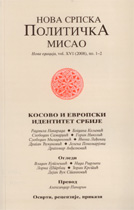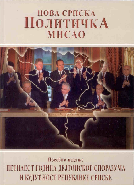| NSPM in English | |||
Sturdy Dominos |
 |
 |
 |
| петак, 20. новембар 2009. | |
|
(The National Interest, 19.11.2009)
Many advocates of continuing or racheting up our presence in Afghanistan are cut from the same domino-theory cloth as those of the Vietnam era. They posit that losing in Afghanistan would almost certainly lead to the further “loss” of the entire South and central Asian region. Although avoiding explicit reference to “falling dominos,” recent examples include S. Frederick Starr (School of Advanced International Studies, Johns Hopkins University); Sir David Richards (the UK’s relatively new Chief of the General Staff); and, in The National Interest, Ahmed Rashid. The fear that Pakistan and central Asian governments are too weak to withstand the Taliban leads logically to the proposition—just as it did forty years ago—that only the United States can defend the region from its own extremist groups and, therefore, that any loss of faith in America will result in a net gain for pan-Islamist movements in a zero-sum global competition for power. Unfortunately, the resurrection of “falling dominos” as a metaphor for predicted consequences of an American military withdrawal reflects a profound inability to re-envision the nature of today’s global political environment and America’s place in it. The current worry is that Pakistan will revive support for the Taliban and return to its historically rooted policy of noninterference in local governance or security arrangements along the frontier. This fear is compounded by a vision of radical Islamists gaining access to Pakistan’s nuclear arsenal. Those concerns are fueled by the judgment that Pakistan’s new democratically elected civilian government is too weak to withstand pressures by its most senior military officers to keep its pro-Afghan Taliban option open. From that perspective, any sign of American “dithering” would reinforce that historically-rooted preference, even as the imperative would remain to separate the Pakistani-Taliban from the Afghan insurgents. Further, any significant increase in terrorist violence, especially within major Pakistani urban centers, would likely lead to the imposition of martial law and return to an authoritarian military regime, weakening American influence even further. At its most extreme, that scenario ends with the most frightening outcome of all—the overthrow of relatively secular senior Pakistani generals by a pro-Islamist and anti-Western group of second-tier officers with access to that country’s nuclear weapons. Beyond Pakistan, advocates of today’s domino theory point to the Taliban’s links to both the Islamic Movement of Uzbekistan and the Islamic Jihad Union, and conclude that a Taliban victory in Afghanistan would encourage similar radical Islamist movements in Kyrgyzstan, Tajikistan, Turkmenistan and Uzbekistan. In the face of a scenario of increasing radicalization along Russia’s relatively new, southern borders, domino theorists argue that a NATO retreat from Afghanistan would spur the projection of its own military and political power into the resulting “vacuum” there. The primary problem with the worst-case scenarios predicted by the domino theorists is that no analyst is really prescient enough to accurately predict how decisions made by the United States today will affect future outcomes in the South and central Asian region. Their forecasts might occur whether or not the United States withdraws or, alternatively, increases its forces in Afghanistan. Worse, it is entirely possible that the most dreaded consequences will occur only as the result of a decision to stay. With the benefit of hindsight, we know that the earlier domino theory falsely represented interstate and domestic political realities throughout most of Southeast Asia in 1975. Although it is true that American influence throughout much of Southeast Asia suffered for a few years following Communist victories in Cambodia, Laos and Vietnam, we now know that while we viewed the Vietnam War as part of a larger conflict, our opponent’s focus was limited to the unification of their own country. Although border disputes erupted between Vietnam and Cambodia, China and the Philippines, actual military conflicts occurred only between the supposedly fraternal Communist governments of Vietnam, China and Cambodia. Neither of the two competing Communist regimes in Cambodia survived. Further, no serious threats to install Communist regimes were initiated outside of Indochina, and, most importantly, the current political situation in Southeast Asia now conforms closely to what Washington had hoped to achieve in the first place. It is, of course, unfortunate that the transition from military conflict in Vietnam to the welcome situation in Southeast Asia today was initially violent, messy, bloody, and fraught with revenge and violations of human rights. But as the perpetrators, magnitude, and victims of violence changed, the level of violence eventually declined. This time around, there are at least two questionable assumptions underlying the resurrection of the domino theory. First, the Taliban is no longer the unified group that emerged during 1994. Instead, the term “Taliban” is applied to several groups engaged in the current insurgency against the Karzai government and NATO forces. Those groups collaborate through a complex set of shifting alliances that extend across the disputed Afghanistan/Pakistan border. Second, given that local Taliban have demonstrated their capacity to effectively engage NATO forces without the equivalent of NATO military and civilian trainers or logistical support, other indigenous groups opposed to the Taliban and/or al-Qaeda are also likely to be stronger than domino theorists assume and are likely to proactively defend themselves against radical Islamists once we are no longer there to do it for them. A retrospective view of America’s involvement in Vietnam and its ultimate consequences for U.S. interests reinforces the aphorism that all politics are local. That truism seems lost on American foreign-policy decision makers who tend to see international threats in global rather than local terms. Further, the danger remains that the metaphor of falling dominos might resonate with governments in the region that face their own increasingly radical domestic opposition. Our fears of regional collapse might also speak to Russian and Chinese policy makers fearful of potentially greater instability along their borders. But such regional threats, even if they do arise, do not threaten the core national interests of the United States—the substantially exaggerated fears of terrorist “safe-havens” notwithstanding. Those worries simply do not justify the overwhelmingly disproportionate and financially ruinous military response that has characterized our involvement there. The “fall of dominos” is no more inevitable in South and central Asia now than it was in Southeast Asia more than a half century ago. True, the earlier circumstances in Vietnam and Southeast Asia are not, in most respects, similar to the current situation in Afghanistan, Pakistan, or the remainder of South and central Asia. Nonetheless, the emphasis in both cases on external interstate threats—rather than on autonomous non-state actors—has been a mistake because it does not reflect the actual source of most violent conflicts since the 1960s. In an exponentially complex world characterized by multiple actors, the domino theory does not help predict the future course of political relations in the region—nor would any other simplistic metaphor. Despite the view that the alliance between various Taliban and al-Qaeda factions is both strategic and long-term, a consensus is forming that most Taliban groups are either nationalists who want to seize formal authority within recognized sovereign-states, or more localized groups that merely want to be left alone by any pretenders to centralized state-authority. Perversely, the desire of nationalist Taliban to seize sovereign-state power represents an acceptance of a largely secular European system of interstate relations. In that conversion will likely be found the seeds of their eventual undoing—as local community-based groups continue to oppose any attempts, whether sponsored by Americans or Islamic radicals, to establish centralized state authority there. The greatest threats to U.S. interests in South and central Asia are likely to be attempts by erstwhile regional allies to leverage American military involvement in support of their own parochial interests. Therefore, as a new foreign policy is being formulated, it would serve us well to remember Thomas Jefferson’s declaration more than two hundred years ago that “our Government . . . [seeks] peace, commerce, and honest friendship with all nations, [but] entangling alliances with none.” That is particularly good advice with respect to any consideration of military interventions within the swath of territory between Iraq to the West and Pakistan to the east. Jerry Mark Silverman has a PhD in international relations-government and, as a Ford Foundation Project Specialist was involuntarily transferred from Saigon to Bangkok just days before the arrival of North Vietnamese forces in April 1975. He is also author of the 1975 article “The Domino Theory: Alternatives to a Self-Fulfilling Prophecy” published that same year in Asian Survey. His most recent publication in TNI Online was “A False Awakening.” |
Од истог аутора
Остали чланци у рубрици
- Playing With Fire in Ukraine
- Kosovo as a res extra commercium and the alchemy of colonization
- The Balkans XX years after NATO aggression: the case of the Republic of Srpska – past, present and future
- Из архиве - Remarks Before the Foreign Affairs Committee of the European Parliament
- Dysfunction in the Balkans - Can the Post-Yugoslav Settlement Survive?
- Serbia’s latest would-be savior is a modernizer, a strongman - or both
- Why the Ukraine Crisis Is the West’s Fault
- The Ghosts of World War I Circle over Ukraine
- Nato's action plan in Ukraine is right out of Dr Strangelove
- Why Yanukovych Said No to Europe

.jpg)








 Withdrawing from Afghanistan won’t cause all of central Asia to turn Islamist.
Withdrawing from Afghanistan won’t cause all of central Asia to turn Islamist.











